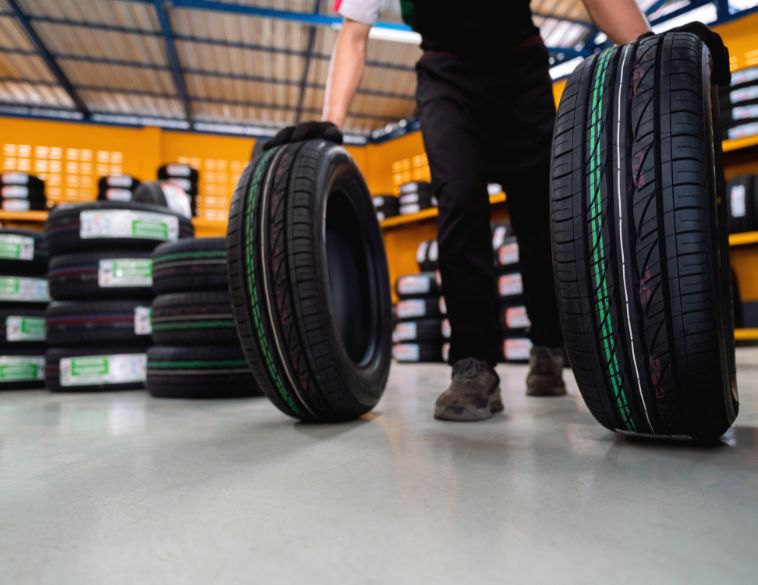A balance of data and educated guessing.

By the time the month of May rolls around, Jared Powell-Williams has already finished ordering his winter tires for the next season.
That’s because the manufacturers are coming to their distribution channels, their customers, in March. “We’ll start looking for orders to come in between March, April and May,” says Powell-Williams, the Vice President of North Country Tire. “We look to start receiving product sometimes as early as June.”
He quips that it’s also about having the best director of purchasing and director of operations in the business! “Between those two departments, it’s as much about the science as it is the artistry of balancing, receiving the outgoing product,” explains Powell-Williams. In the tire industry, the close relationship from purchasing into operation into marketing, and of course sales, will get the best sell-through.
It’s a case of looking at what’s been doing well historically, and then deciding at what level it makes sense to increase what has worked in the past to ensure there’s enough product available for future growth. “We can’t always base it on historical sales,” reports Powell-Williams. He credits leaning on good relationships with tire manufacturers and OEs to see where they may be finding opportunities.
Educated guesses
For example, electric vehicles. “We weren’t even talking about EVs ten years ago,” he points out. Now all the manufacturers want to play in that arena. Since EVs are heavy vehicles with a great deal of torque, the wear on tires is significant. “Tires are at the forefront of consumer safety as well as enjoyment.”
On top of all the data, it’s a matter of making educated guesses about where the market is going while looking at what the environment is today. “Areas that previously wouldn’t be an opportunity may now be very lucrative,” says Powell-Williams. “It truly is a balancing act.”
Over at Fountain Tire, Ken Miller, Director of Inventory, has already done his ordering. “Winter planning begins before the snow has even melted from the previous year,” he reports. This year, all of Miller’s planning was complete and the winter booking orders were placed with vendors by the first week of April.
Before ordering begins, there’s an analysis of historical sales data. Then, market intelligence from vendors, the Fountain Tire sales team and store managers are layered in. Using this aggregate of information, forecasting software is leveraged to build a plan that satisfies the assortment, price point and profitability goals.
Historical data
“It varies from year to year, but usually historical data provides 80 percent of the direction we need to go,” notes Miller. In the past two years, there have also been many transitions from one product line to another product line, introducing new brands. For example, this year, the Cooper brand was added to Goodyear’s line. “We’re highly aligned with Goodyear, so it’s exciting for us to incorporate all the Cooper winter options.”
There are still some lingering supply chain issues and vendors are scrambling between factories to ensure they can meet the demands of customers. “Last year we transitioned many products that had historically been produced domestically,” explains Miller. “A higher proportion of our product was shifted to offshore, which seemed to have better production.”
He stays on top of emerging trends like EVs through communication with his partner networks. There’s also the Goodyear category management team, which operates at arm’s length from Goodyear, and provides valuable OE and car part data. “That really helps forecast demand in the coming season as well,” says Miller.
The Goodyear category management team can provide information about how many EVs are within a specific area. “We take those specific areas and we have a ballpark of how many vehicles are there,” reports Miller. “Then we can estimate what kind of demand there might be, and layer in orders accordingly.”
The vendors with whom Fountain Tire has partnered will help drive the highest level of brands they’re going to assort. More detailed assortment planning occurs once they’re aligned with those vendors whose products will be produced first, and then the products that will be required to satisfy the various applications and target price points.
Excel spreadsheets

There’s always concern about the timing of getting products across the ocean, through the ports, on the rails and on trucks. “That’s really still unpredictable,” says Miller. “Canadian ports can be very tricky.”
A robust forecasting tool helps with the planning, but old-school Excel spreadsheets play an important part too. “Our store managers are trained to use spreadsheets,” explains Miller. “We spend a lot of time training them to use spreadsheets and that helps them analyze their own historical sales specific to their stores. It helps them create and customize winter stocking plans for their particular location.”
Retailers capable of housing the inventory can purchase factory direct containers from Dynamic Tire, while some will purchase from the warehouse, according to Mike Matesic, Product Segment Manager at Dynamic Tire. “When we have the factory direct ordering cycle, it’s usually done by the end of May.”
It’s important to forecast ahead because factories that are producing tires have to order materials that are different from all-season tires. Production time could be anywhere from 30 to 45 days, 45 to 60 days on a ship, and then seven to 10 days to come across Canada. “That way, they can be delivered with time to spare,” says Matesic.
Educate yourself
Historical data is always reviewed to determine what product will be ordered. According to Matesic, vehicles change every three to four years. And the lifespan of a tire is three to four years, depending on how a vehicle is driven.
“When a consumer changes their car, will they be buying something with the same size or will it be a different size?” asks Matesic. “You have to know your customer, know your market, look at vehicle trends, new products, new pricing. Educate yourself.”
He recalls that last year, transport issues caused delays. “A lot of the winter tires were coming later in the season, which caused shortages and people panicked, buying whatever they could,” Matesic says. “When some of the inventory came in later on, retailers had replaced it with other items. There was an over-inventory later in the season which carried over into this year.”
Timing is important to have the right stock at hand. Ugo Desgreniers, purchasing director at Distribution Stox, says it’s the distributor’s responsibility to have tires ready for sale. “Sales are always in the same six to eight weeks every fall,” he emphasizes. “The distributor needs to have all those tries by September.”
Unlike other tire segments, manufacturers only run one production of winter tires every year. “So you need to order and fill up your warehouses with winter tires,” he notes. “Our strategy as a distributor is to order as many tires as will fit in our warehouses.”
In Quebec, where winter tires are mandatory, he recommends shops call their customers in advance to make appointments. “You need to start in September to put the tires on your customers’ tires in time for the mandatory deadline.”






 MONTRÉAL
MONTRÉAL Full time
Full time


